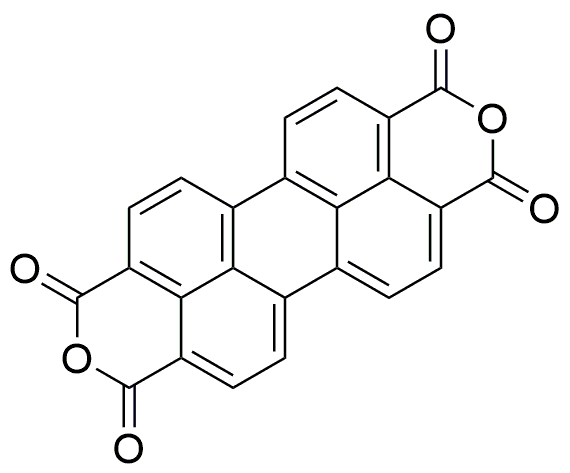3,4,9,10-Perylenetetracarboxylic dianhydride is widely utilized in research focused on:
- Organic Electronics: This compound is a key material in the development of organic semiconductors, which are essential for manufacturing flexible displays and solar cells. Its excellent charge transport properties enhance device performance.
- Polymer Chemistry: It serves as a building block for synthesizing high-performance polymers and composites. These materials are used in coatings and adhesives, providing superior thermal stability and mechanical strength.
- Fluorescent Dyes: The compound is employed in the production of fluorescent probes for biological imaging. Its strong fluorescence makes it ideal for tracking cellular processes in research and diagnostics.
- Photovoltaic Applications: In solar energy, it is used in the formulation of dye-sensitized solar cells (DSSCs), improving light absorption and energy conversion efficiency.
- Environmental Monitoring: This chemical is utilized in the development of sensors for detecting pollutants. Its sensitivity to environmental changes makes it valuable for monitoring air and water quality.
General Information
Properties
Safety and Regulations
Applications
3,4,9,10-Perylenetetracarboxylic dianhydride is widely utilized in research focused on:
- Organic Electronics: This compound is a key material in the development of organic semiconductors, which are essential for manufacturing flexible displays and solar cells. Its excellent charge transport properties enhance device performance.
- Polymer Chemistry: It serves as a building block for synthesizing high-performance polymers and composites. These materials are used in coatings and adhesives, providing superior thermal stability and mechanical strength.
- Fluorescent Dyes: The compound is employed in the production of fluorescent probes for biological imaging. Its strong fluorescence makes it ideal for tracking cellular processes in research and diagnostics.
- Photovoltaic Applications: In solar energy, it is used in the formulation of dye-sensitized solar cells (DSSCs), improving light absorption and energy conversion efficiency.
- Environmental Monitoring: This chemical is utilized in the development of sensors for detecting pollutants. Its sensitivity to environmental changes makes it valuable for monitoring air and water quality.
Documents
Safety Data Sheets (SDS)
The SDS provides comprehensive safety information on handling, storage, and disposal of the product.
Product Specification (PS)
The PS provides a comprehensive breakdown of the product’s properties, including chemical composition, physical state, purity, and storage requirements. It also details acceptable quality ranges and the product's intended applications.
Certificates of Analysis (COA)
Search for Certificates of Analysis (COA) by entering the products Lot Number. Lot and Batch Numbers can be found on a product’s label following the words ‘Lot’ or ‘Batch’.
*Catalog Number
*Lot Number
Certificates Of Origin (COO)
This COO confirms the country where the product was manufactured, and also details the materials and components used in it and whether it is derived from natural, synthetic, or other specific sources. This certificate may be required for customs, trade, and regulatory compliance.
*Catalog Number
*Lot Number
Safety Data Sheets (SDS)
The SDS provides comprehensive safety information on handling, storage, and disposal of the product.
DownloadProduct Specification (PS)
The PS provides a comprehensive breakdown of the product’s properties, including chemical composition, physical state, purity, and storage requirements. It also details acceptable quality ranges and the product's intended applications.
DownloadCertificates of Analysis (COA)
Search for Certificates of Analysis (COA) by entering the products Lot Number. Lot and Batch Numbers can be found on a product’s label following the words ‘Lot’ or ‘Batch’.
*Catalog Number
*Lot Number
Certificates Of Origin (COO)
This COO confirms the country where the product was manufactured, and also details the materials and components used in it and whether it is derived from natural, synthetic, or other specific sources. This certificate may be required for customs, trade, and regulatory compliance.


